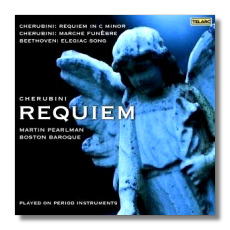
The Internet's Premier Classical Music Source
Related Links
- Cherubini Reviews
- Latest Reviews
- More Reviews
-
By Composer
-
Collections
DVD & Blu-ray
Books
Concert Reviews
Articles/Interviews
Software
Audio
Search Amazon
Recommended Links
Site News
 CD Review
CD Review
Luigi Cherubini

Requiem
- Luigi Cherubini:
- Requiem in C minor
- Marche funèbre
- Ludwig van Beethoven: Elegiac Song (Elegischer Gesang), Op. 118
Boston Baroque/Martin Pearlman
Telarc CD-80658 DDD 50:38
Also released on Hybrid Multichannel SACD SACD-60658
Amazon
- UK
- Germany
- Canada
- France
- Japan
- ArkivMusic
- CD Universe
The first performance of Cherubini's C-minor Requiem took place on January 21, 1817 under unusual circumstances. It was performed in a crypt below the abbey church of St. Denis, where many of the French kings lay buried, including victims of the French revolution, namely Louis XVI and Marie Antoinette. The Requiem had been commissioned by the government of King Louis XVIII specifically for this purpose, and despite the solemnity of the occasion, the music quickly achieved a measure of popularity, and was praised by the likes of Beethoven, Berlioz, and Schumann. By the end of the century, however, Cherubini's Requiem had slipped into oblivion – along with much of his other music – only to be "rediscovered" in the LP era.
The music looks both backward and forward. In 1805, Cherubini introduced Mozart's own Requiem to Paris, and so it is not surprising that Cherubini's Requiem, while it anticipates the Romantic era in many ways, has much in common with Mozart's, down to the fugal treatment of "Quam olim Abrahae" in the Offertorium. At the same time, Cherubini's Requiem is appealingly small-scaled, almost intimate. In particular, the first two sections have a conciliatory tenderness reminiscent of Fauré's Requiem, although that masterpiece would not be composed for several decades yet. How many musicians could be accommodated in the initial performance space? Not many, one guesses, and so the work's economy – there are no vocal soloists, after all – probably was dictated by circumstances as much as by Cherubini's artistic preferences.
It is appropriate, then, that this new recording uses a modest number of musicians: less than 40 instrumentalists and 23 choristers. Some of the Requiem's earlier recordings used much larger forces, and while that was impressive, I think the sincerely devout quality of Cherubini's music is better served here. Furthermore, Boston Baroque is a period performance ensemble, and the wiry sound of the strings, the nasal winds, and the cutting brass supply all the drama that is needed. The performance doesn't lack passion, though: hear the "Dies Irae" and the hairs should rise on the back of your neck.
The Requiem's frequent disc-mate is the Marche funèbre (Funeral march) offered here as a postlude. This is a work from 1820 composed for a funeral service in the Royal Chapel. Even more than in the Requiem, the tam-tam (or gong) plays a prominent role. This is "open air" music, as opposed to the Requiem, which was composed for claustrophobic performance conditions. By not taming its native wildness, Pearlman makes a convincing case for it. The disc opens with Beethoven's unusual Elegiac Song, a work from 1814, near the start of his so-called "late period." This is a setting of a memorial text believed to be by the composer's friend Baron Pasqualati, whose wife had died three years earlier. The original version was for four solo voices with string quartet, but here it is performed by the chorus with strings (sans double basses) – a simple enough conversion, I suppose.
Even with the addition of Beethoven's "bonus," this is a short CD, and the Cherubini Requiem really is not as rare as Telarc seems to want us to believe. Nevertheless, this is a desirable disc, and it makes for a strong start to the label's classical releases for 2007.
Copyright © 2007, Raymond Tuttle




















